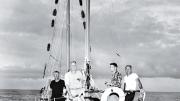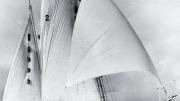Addressing the Democratic National Convention in Charlotte, North Carolina, last September, Georgia congressman John Lewis recalled his first visit to the city—in 1961, as one of the 13 original Freedom Riders. Their bus trip was planned by the Congress of Racial Equality (CORE) as a journey from Washington, D.C., to New Orleans to test a 1960 Supreme Court ruling banning racial discrimination in interstate public facilities. Just south of Charlotte, in Rock Hill, South Carolina, Lewis and his seatmate, Albert Bigelow ’29, tried to enter a white waiting room. “We were met by an angry mob that beat us and left us lying in a pool of blood,” said Lewis. “Some police officers came up and asked us whether we wanted to press charges. We said no. We come in peace, love, and nonviolence.”
Lewis would later describe “Bert” Bigelow, born into a prominent Boston family steeped in Harvard connections, as “a big, rugged-looking guy from New England who looked as if he belonged on a sailing ship a century ago.” And several years before he boarded that bus, Bigelow had sailed, literally, into the annals of mid-twentieth-century nonviolent protest and political activism. In the spring of 1958, as skipper of a 30-foot ketch, the Golden Rule, he and four other men tried twice to navigate into the Pacific nuclear-bomb testing grounds at Eniwetok Atoll in the Marshall Islands to protest nuclear proliferation. Each time, the voyage was foiled by the U.S. Coast Guard and Bigelow was eventually jailed for 60 days in Honolulu—but the attendant publicity provided him with a stage for his political views.
Bigelow explained the evolution of his activism in his 1959 book, The Voyage of the Golden Rule. “Later in World War II,” he wrote, “I was Captain of the destroyer escort Dale W. Peterson—DE 337—and I was on her bridge as we approached Pearl Harbor from San Diego when the first news arrived of the explosion of the atomic bomb over Hiroshima. Although I had no way of understanding what an atom bomb was I was absolutely awestruck, as I suppose all men were for a moment. Intuitively it was then that I realized for the first time that morally war is impossible.”
Bigelow described himself as he entered the navy as having “an enormous latent desire to conform, to ‘go along.’ ” He had studied architecture at MIT after Harvard and then worked at designing residences; he also helped design buildings for the 1939 New York World’s Fair. Left a widower after a brief and tragic first marriage, he married Sylvia Weld, an actress, in 1931. After the war, he searched for “some sort of unified life-philosophy or religion,” and eventually followed his wife in joining the Quakers, in 1954. A year later, with their own two daughters grown, the Bigelows welcomed into their Greenwich, Connecticut, home two “Hiroshima Maidens,” young women who had been injured and disfigured by the A-bomb blast and then brought to the United States for plastic surgery. Bigelow’s experience with the two women, he wrote, “forced me to see that I had no choice but to make the commitment to live, as best I could, a life of nonviolence and reconciliation.”
In 1956, before the presidential election, he sent $300 to Dr. Martin Luther King Jr. and mentioned his plan to write in King’s name for president. In 1958, he became involved with an anti-nuclear-proliferation docudrama, Which Way the Wind, sponsored by the American Friends Service Committee; he served as a producer and narrated performances after his Pacific expedition. One of the Golden Rule’s crew members, James Peck ’36, a union organizer, was also active in CORE projects and Bigelow later joined him in civil-rights causes, including that first Freedom Ride. He also continued to speak out tirelessly against the arms race in print and at rallies at home and abroad. Reflecting on his years of activism in 1964, he wrote, “I remain an optimist despite mounting evidence that, if we do not blow ourselves off the earth, we shall soon eat ourselves off the earth.” (Vegetable gardening, he added, had become a “principal side interest.”)
By the mid 1960s, his public activism quieted, though he still railed in lectures and letters against nuclear proliferation. He savored sailing and a longtime love—painting (the Mystic Seaport museum in Connecticut owns eight of his marine works)—and stayed involved in community affairs, at one point as “the sole male member of the [local] League of Women Voters.”
Although Bigelow’s prominence faded, his name and activism live on, in commemorations of the Freedom Rides and through the efforts of Veterans for Peace, a national organization of military veterans committed to the cause of world peace. The group is far along in its work to restore the Golden Rule (found derelict in a small California shipyard) and ultimately sail it as both a symbol and a classroom for instruction against the “manufacture and use of nuclear weapons.” The project serves as a fitting legacy for a man born to privilege who was jolted from complacency by the devastation wrought by war and committed himself to justice and peace.
“I sense that most of us feel overwhelmed by a disintegrating world, seemingly beyond our control,” he wrote in his fiftieth anniversary class report. “…At the same time, we have the potential to preserve and enhance our delicate, beautiful planet and create on it a society of respect, sharing, and caring—where love will not be considered a sign of weakness.”









